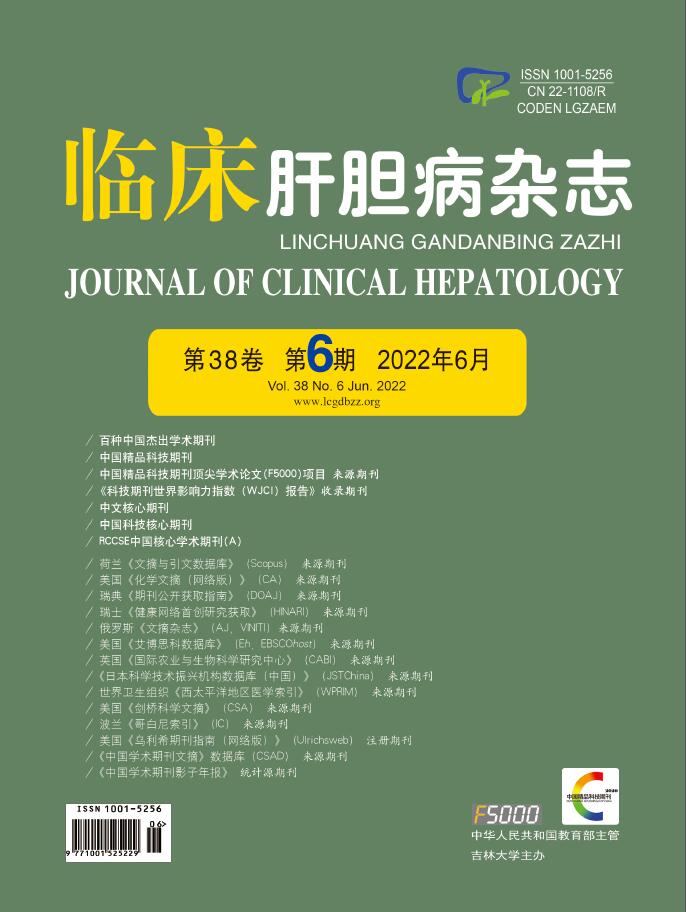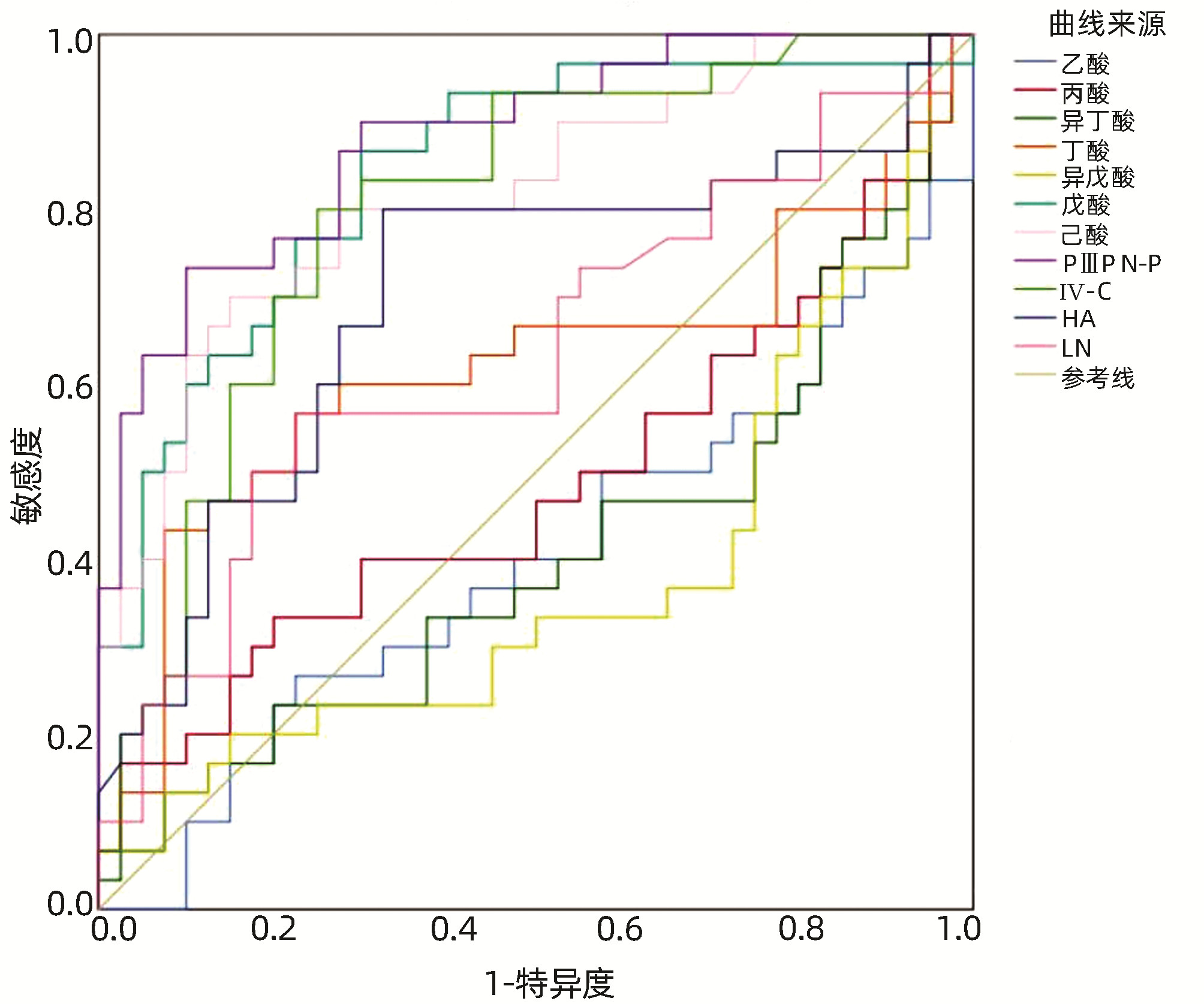| [1] |
RINELLA ME, SANYAL AJ. NAFLD in 2014: Genetics, diagnostics and therapeutic advances in NAFLD[J]. Nat Rev Gastroenterol Hepatol, 2015, 12(2): 65-66. DOI: 10.1038/nrgastro.2014.232. |
| [2] |
National Workshop on Fatty Liver and Alcoholic Liver Disease, Chinese Society of Hepatology, Chinese Medical Association; Fatty Liver Expert Committee, Chinese Medical Doctor Association. Guidelines of prevention and treatment for nonalcoholic fatty liver disease: A 2018 update[J]. J Clin Hepatol, 2018, 34(5): 947-957. DOI: 10.3969/j.issn.1001-5256.2018.05.007. |
| [3] |
JIAN J, ZHU X. Biological mechanism of intestinal flora in the occurrence and development of nonalcoholic fatty liver disease[J]. Chin J Biochem Mol Biol, 2020, 36(8): 888-894. DOI: 10.13865/j.cnki.cjbmb.2020.05.1061. |
| [4] |
MURAG S, AHMED A, KIM D. Recent epidemiology of nonalcoholic fatty liver disease[J]. Gut Liver, 2021, 15(2): 206-216. DOI: 10.5009/gnl20127 |
| [5] |
MICHELOTTI GA, MACHADO MV, DIEHL AM. NAFLD, NASH and liver cancer[J]. Nat Rev Gastroenterol Hepatol, 2013, 10(11): 656-665. DOI: 10.1038/nrgastro.2013.183. |
| [6] |
FRIEDMAN SL, NEUSCHWANDER-TETRI BA, RINELLA M, et al. Mechanisms of NAFLD development and therapeutic strategies[J]. Nat Med, 2018, 24(7): 908-922. DOI: 10.1038/s41591-018-0104-9. |
| [7] |
BUZZETTI E, PINZANI M, TSOCHATZIS EA. The multiple-hit pathogenesis of non-alcoholic fatty liver disease (NAFLD)[J]. Metabolism, 2016, 65(8): 1038-1048. DOI: 10.1016/j.metabol.2015.12.012. |
| [8] |
HUI DC, SUN MY. Association between nonalcoholic fatty liver disease and gut microbiota based on the theory of gut-liver axis[J]. J Clin Hepatol, 2020, 36(7): 1627-1630. DOI: 10.3969/j.issn.1001-5256.2020.07.039. |
| [9] |
MENG Q, DUAN XP, WANG CY, et al. Alisol B 23-acetate protects against non-alcoholic steatohepatitis in mice via farnesoid X receptor activation[J]. Acta Pharmacol Sin, 2017, 38(1): 69-79. DOI: 10.1038/aps.2016.119. |
| [10] |
PINGITORE A, CHAMBERS ES, HILL T, et al. The diet-derived short chain fatty acid propionate improves beta-cell function in humans and stimulates insulin secretion from human islets in vitro[J]. Diabetes Obes Metab, 2017, 19(2): 257-265. DOI: 10.1111/dom.12811. |
| [11] |
JIN CJ, SELLMANN C, ENGSTLER AJ, et al. Supplementation of sodium butyrate protects mice from the development of non-alcoholic steatohepatitis (NASH)[J]. Br J Nutr, 2015, 114(11): 1745-1755. DOI: 10.1017/S0007114515003621. |
| [12] |
PERRY RJ, PENG L, BARRY NA, et al. Acetate mediates a microbiome-brain-β-cell axis to promote metabolic syndrome[J]. Nature, 2016, 534(7606): 213-217. DOI: 10.1038/nature18309. |
| [13] |
ZHOU D, FAN JG. Microbial metabolites in non-alcoholic fatty liver disease[J]. World J Gastroenterol, 2019, 25(17): 2019-2028. DOI: 10.3748/wjg.v25.i17.2019. |
| [14] |
CUI Y, WANG Q, CHANG R, et al. Intestinal barrier function-non-alcoholic fatty liver disease interactions and possible role of gut microbiota[J]. J Agric Food Chem, 2019, 67(10): 2754-2762. DOI: 10.1021/acs.jafc.9b00080. |
| [15] |
Fatty liver and alcoholic liver disease group, Hepatology branch, Chinese Medical Association. Guidelines for the diagnosis and treatment of nonalcoholic fatty liver disease[J]. Chin Hepatol, 2006, 11(1): 68-70. DOI: 10.3969/j.issn.1008-1704.2006.01.032. |
| [16] |
LIKHITSUP A, DUNDULIS J, ANSARI S, et al. Prevalence of non-alcoholic fatty liver disease on computed tomography in patients with inflammatory bowel disease visiting an emergency department[J]. Ann Gastroenterol, 2019, 32(3): 283-286. DOI: 10.20524/aog.2019.0371. |
| [17] |
YOUNOSSI ZM, MARCHESINI G, PINTO-CORTEZ H, et al. Epidemiology of nonalcoholic fatty liver disease and nonalcoholic steatohepatitis: Implications for liver transplantation[J]. Transplantation, 2019, 103(1): 22-27. DOI: 10.1097/TP.0000000000002484. |
| [18] |
LOOMBA R, FRIEDMAN SL, SHULMAN GI. Mechanisms and disease consequences of nonalcoholic fatty liver disease[J]. Cell, 2021, 184(10): 2537-2564. DOI: 10.1016/j.cell.2021.04.015. |
| [19] |
THANAPIROM K, TSOCHATZIS EA. Non-alcoholic fatty liver disease (NAFLD) and the quest for effective treatments[J]. Hepatobiliary Surg Nutr, 2019, 8(1): 77-79. DOI: 10.21037/hbsn.2018.11.06. |
| [20] |
DOU KF, YANG XS. Surgeons should attach importance to the understanding of metabolic associated fatty liver disease[J]. Chin J Dig Surg, 2021, 1(1): 40-45. DOI: 10.3760/cma.j.cn115610-20201214-00780. |
| [21] |
|
| [22] |
ZHANG YN, LIU YT. Correlation between the degree of liver fibrosis and chronic kidney disease in patients with nonalcoholic fatty liver disease[J]. Chin J Gerontol, 2021, 41(19): 4214-4218. DOI: 10.3969/j.issn.1005-9202.2021.19.018. |
| [23] |
GANAPATHY V, THANGARAJU M, PRASAD PD, et al. Transporters and receptors for short-chain fatty acids as the molecular link between colonic bacteria and the host[J]. Curr Opin Pharmacol, 2013, 13(6): 869-874. DOI: 10.1016/j.coph.2013.08.006. |
| [24] |
LIU SZ, ZHANG Y, ZHANG MW, et al. Research progress on the production mechanism and physiological function of intestinal short chain fatty acids[J]. Guangdong Agricultural Science, 2013, 40(11): 99-103. DOI: 10.3969/j.issn.1004-874x.2013.11.029.
|
| [25] |
BOETS E, GOMAND SV, DEROOVER L, et al. Systemic availability and metabolism of colonic-derived short-chain fatty acids in healthy subjects: A stable isotope study[J]. J Physiol, 2017, 595(2): 541-555. DOI: 10.1113/JP272613. |
| [26] |
|
| [27] |
TILG H, MOSCHEN AR, RODEN M. NAFLD and diabetes mellitus[J]. Nat Rev Gastroenterol Hepatol, 2017, 14(1): 32-42. DOI: 10.1038/nrgastro.2016.147. |
| [28] |
KHNEIZER G, RIZVI S, GAWRIEH S. Non-alcoholic fatty liver disease and diabetes mellitus[J]. Adv Exp Med Biol, 2021, 1307: 417-440. DOI: 10.1007/5584_2020_532. |
| [29] |
POLYZOS SA, KOUNTOURAS J, MANTZOROS CS. Obesity and nonalcoholic fatty liver disease: From pathophysiology to therapeutic[J]. Metabolism, 2019, 92: 82-97. DOI: 10.1016/j.metabol.2018.11.014. |
| [30] |
YIN JM. Investigation on NAFLD prevalence and risk factors based on physical examination population[D]. Tianjin: Tianjin Medical University, 2012.
殷珺妹. 基于健康体检人群的NAFLD患病率及危险因素调查[D]. 天津: 天津医科大学, 2012.
|
| [31] |
EDDOWES PJ, SASSO M, ALLISON M, et al. Accuracy of fibroScan controlled attenuation parameter and liver stiffness measurement in assessing steatosis and fibrosis in patients with nonalcoholic fatty liver disease[J]. Gastroenterology, 2019, 156(6): 1717-1730. DOI: 10.1053/j.gastro.2019.01.042. |
| [32] |
VUPPALANCHI R, SIDDIQUI MS, VAN NATTA ML, et al. Performance characteristics of vibration-controlled transient elastography for evaluation of nonalcoholic fatty liver disease[J]. Hepatology, 2018, 67(1): 134-144. DOI: 10.1002/hep.29489. |
| [33] |
CHENG J, LI FL, ZHANG B, et al. Effect of high-fat diet on intestinal short chain fatty acids in rats with nonalcoholic fatty liver disease[J]. Chin J Clin Nutr, 2016, 24(4): 236-240. DOI: 10.3760/cma.j.issn.1674-635x.2016.04.009.
|
| [34] |
LIANG Y, LIN C, ZHANG Y, et al. Probiotic mixture of Lactobacillus and Bifidobacterium alleviates systemic adiposity and inflammation in non-alcoholic fatty liver disease rats through Gpr109a and the commensal metabolite butyrate[J]. Inflammopharmacology, 2018, 26(4): 1051-1055. DOI: 10.1007/s10787-018-0479-8. |








 DownLoad:
DownLoad: